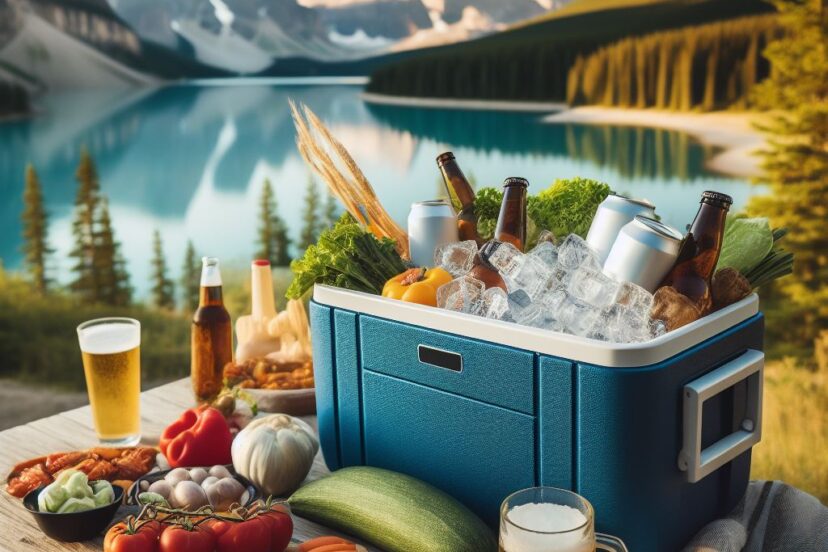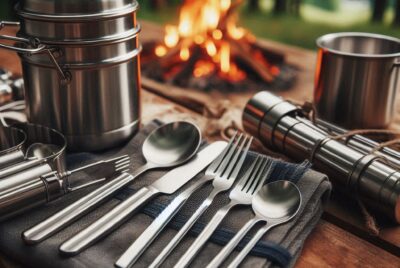Camping Cooler: Keeping Your Adventures Fresh
*We may earn a commission for purchases made using our links. Please see our disclosure to learn more.
Camping Cooler Essentials: Choosing the Perfect Outdoor Companion
Camping coolers are an essential component for outdoor enthusiasts aiming to keep their food and beverages cold while venturing out into the wild. My personal experiences have taught me the importance of choosing a cooler that is not only roomy enough to store perishables but also durable enough to withstand the rigors of outdoor life. The ideal camping cooler comes with robust insulation, rugged construction, and features that enhance portability.
In recent years, the market has expanded to include a variety of camping coolers that cater to different needs. Whether I’m planning a short trip or a prolonged expedition, there’s a cooler designed to meet my requirements. From heavy-duty, bear-resistant bins to lightweight, soft-sided bags, the choices vary, helping me balance between performance, space, and convenience.
When selecting a camping cooler, I always consider the length of my trips, the size of the group, and the type of terrain. Coolers like the Bison Softpak offer long-term durability and are built for years of use, while options like the RovR RollR or YETI Wheeled Roadie offer enhanced maneuverability with their rolling features. I’ve also noticed that size can be crucial—larger coolers are great for big groups, while compact models fit smaller cars or solo adventures. The key is to find a balance between ice retention capabilities and the practicality of transporting the cooler to and from campsites.
Understanding Camping Coolers

When I prepare for camping, one of the most critical considerations is the type of cooler that will best suit my needs. Factors like cooler construction and material directly impact their performance and suitability for different camping situations.
Types of Coolers
During my time outdoors, I’ve noticed coolers come in many forms, each catering to specific needs. Hard shell coolers are the traditional choice, known for robustness and better insulation. They are often constructed using rotomolded techniques, which provide a durable one-piece design. Soft coolers, on the other hand, are lightweight and easier to transport, making them ideal for short trips and day use. Their flexibility allows them to fit in spaces where hard coolers cannot.
For those who prefer high-tech solutions, electric coolers offer convenience by eliminating the need for ice, though they do need a power source. These coolers often double as food warmers, making them versatile companions for road trips and base camps.
Material and Construction
Materials used in cooler construction significantly influence their insulative capabilities and durability.
- Hard shell coolers often feature rotomolded construction, providing a seamless, dense plastic shell that excels in insulation and is bear-resistant.
- Soft coolers are typically made from high-grade nylon or polyester with insulation layers to maintain the temperature for a day or two. These materials offer the dual benefits of lightness and some degree of water resistance.
The selection between these materials should be guided by the intended use; rotomolded hard shell coolers for their ruggedness and superior ice retention, or the portability and convenience of soft coolers for less demanding conditions.
Key Features to Consider

When selecting a camping cooler, I prioritize three main aspects: its ability to preserve ice, the practicality of its size and capacity, and the convenience of its transportability.
Insulation and Ice Retention
My cooler’s insulation quality is critical for maintaining the coldness of its contents. The duration of ice retention varies among coolers, and for my trips, I look for at least 2 days of ice retention. A thick, well-sealed lid and insulated walls are essential features to ensure that my food and drinks stay chilled.
Capacity and Size
I always consider both the external and internal dimensions of the cooler, as this affects how much I can store and how easily the cooler will fit in my vehicle. A cooler that claims a 60-quart capacity but measures 52 quarts internally means that I need to plan accordingly. Coolers with a range of sizes like 45-quart, 60-quart, and 80-quart options allow me to choose based on the length of my trip and the group size.
Portability and Transportation
The ease of moving my cooler is a key factor. If my campsite is a distance from my car, I’ll opt for a cooler that is lightweight yet durable. Wheels and a telescoping handle are advantageous for transport over longer distances. For shorter treks, a cooler with rope handles or padded straps might be sufficient. Accessories like cup holders add convenience, so long as they do not compromise the cooler’s portability.
Top Camping Cooler Brands

When planning a camping trip, a reliable cooler is essential. I’ll explore top brands that stand out for their quality, durability, and whether they are bear-resistant or not, helping you decide on the best cooler for your outdoor adventures.
High-End Brands
- YETI: Known for their bear-proof designs, YETI offers coolers like the rugged YETI Tundra 65 and the portable YETI Roadie 60, both epitomizing durability and ice retention capabilities. They have set a high standard for quality camping coolers.
- RovR Rollr: The RovR Rollr 60 cooler merges portability with high-end features, boasting wheels for easy transportation and noteworthy insulation performance. RovR Rollr coolers are an investment for serious campers.
- ORCA: This brand is known for heavy-duty coolers. A notable one is the ORCA 40-Quart, which provides excellent ice retention and durability, plus it’s bear-resistant which adds to campsites’ safety.
- OtterBox Venture: The OtterBox Venture 25 is praised for its tough construction and certified bear resistance, guaranteeing that your food stock is well-protected from both weather and wildlife.
Budget-Friendly Options
- Igloo: Offering a wide range of coolers, Igloo stands out with affordable yet reliable options. Their coolers are known for practical features and decent ice retention.
- Coleman: For campers looking for the best budget coolers, Coleman offers affordable alternatives without compromising much on quality. Durable and easy to handle, Coleman coolers are a go-to for many campers.
- RTIC: Comparable to some pricier counterparts like YETI, RTIC provides quality coolers such as the RTIC 65 at a more accessible price point. They manage to balance cost with performance effectively.
These brands reflect the spectrum of camping coolers available on the market, catering to different needs and budgets. Whether prioritizing bear-proof features or looking for the best value, there is a cooler brand out there that will meet your camping requirements.
Camping Cooler: Enhancing Your Camping Experience

A proper cooler enhances camping by keeping your provisions fresh and drinks chilled. As someone who enjoys the nuance of outdoor gear, I understand that the best coolers for camping come down to two crucial aspects: useful accessories and diligent maintenance.
Must-Have Camping Cooler Accessories
When choosing accessories for my cooler, I focus on features that improve functionality and convenience. Here is a list of some essential cooler accessories that enhance the camping experience:
- All-Terrain Wheels: Necessary for maneuverability over rocks and roots, especially for car camping.
- Bear-Proof Certification: Important for safety when camping in bear-populated areas; a rugged cooler with this feature brings peace of mind.
- Waterproof Covers: Keep the contents dry even when it rains; doubles as a floatation device.
- Solar Panels: For the tech-savvy camper, some coolers now come with solar panels attached for charging devices on-the-go.
- Dry Bags: Ideal for compartmentalizing items within a large cooler, ensuring delicate items remain dry and secure.
- Insulated Tote Bags: For quick jaunts from the campsite or a backyard barbecue, a compact, well-made tote keeps essentials ice-cold.
Camping Cooler Maintenance and Use
I can’t stress enough that taking care of your cooler ensures longevity and peak performance. Here’s how I maintain my cooler:
- Pre-Cooling: Before loading it with food and drinks, I chill my cooler with ice to maximize ice retention.
- Cleanliness: After each trip, cleaning it with a mild detergent and water prevents odors and stains.
- Dry Storage: I always ensure my cooler is completely dry before storing to thwart mildew or mold.
- Regular Checks: Inspecting the seals and latches, and fixing any loose parts promptly keeps it functional for the next trip.
Remember, whether it’s for a rugged adventure or a laid-back outdoor gathering, the right cooler with proper upkeep is a game-changer.
Camping Cooler – Safety and Wildlife Protection

Ensuring safety and wildlife protection during camping trips is a priority for me. Not only does it secure my food and gear from wildlife interference, but it also maintains the balance of the natural habitat by preventing animal access to human food.
Bear-Resistant Features
Bear-proof or bear-resistant coolers are essential if camping in bear country. They are designed with lockable lids and sturdy materials to withstand attempts by bears to access the contents. Features such as integrated padlock holes make it possible for me to secure the cooler with bear-proof locks, adding an additional layer of safety.
- Lock mechanisms: These should be sturdy and complex enough to deter bears.
- Materials: The body should be constructed from durable materials like rotomolded plastic.
- Certifications: Look for coolers with an IGBC (Interagency Grizzly Bear Committee) certification, ensuring they’ve been tested for bear resistance.
Leak and Waterproof Protection
A watertight seal is critical in preventing leaks from the cooler, which is important for both maintaining the integrity of my food and avoiding the attraction of wildlife to my campsite.
- Gasket: A quality rubber gasket along the lid is a key feature for maintaining a waterproof seal.
- Latches: Pull-down latches or rubber T-grips usually provide a secure closure, enhancing the cooler’s waterproofing capability and preventing any seepage.
By focusing on these protective features, I ensure my camping experience is safe and minimizes negative impact on wildlife.
FAQs About Your Camping Cooler
In this section, I will cover some of the most common concerns and inquiries campers have regarding camping coolers. I aim to provide clear and precise answers to optimize your camping experience.
What factors should I consider when choosing a camping cooler with wheels?
When selecting a camping cooler with wheels, it’s important to look at the terrain it can handle. A cooler like the Rovr RollR 60 is designed for rugged environments. Additionally, consider the wheel size, the handle’s ergonomics, and the cooler’s overall stability.
Which camping cooler offers the best ice retention for extended trips?
For lengthy camping trips where ice retention is crucial, high-end coolers such as those from Yeti are designed to keep ice frozen for several days. Their thick insulation and robust seal systems help to maintain low internal temperatures.
How do I determine the appropriate size for a small camping cooler?
For a small camping cooler, size should be based on the number of people and the trip duration. A 25-50 quarts cooler typically suffices for a weekend trip for two. For solo day trips, a personal cooler of 4-10 quarts may be sufficient.
What are the advantages of using an electric camping cooler over a traditional one?
Electric camping coolers provide the convenience of not needing ice, thus freeing up more space for storage. They can be powered by your car or a portable power source and are able to maintain a consistent cooling temperature.
Are high-end coolers like Yeti worth the investment for regular campers?
For regular campers who frequently face harsh conditions or require extended ice retention, investing in a high-end cooler like Yeti can be worthwhile. Their durability and superior insulation can enhance the overall camping experience.




